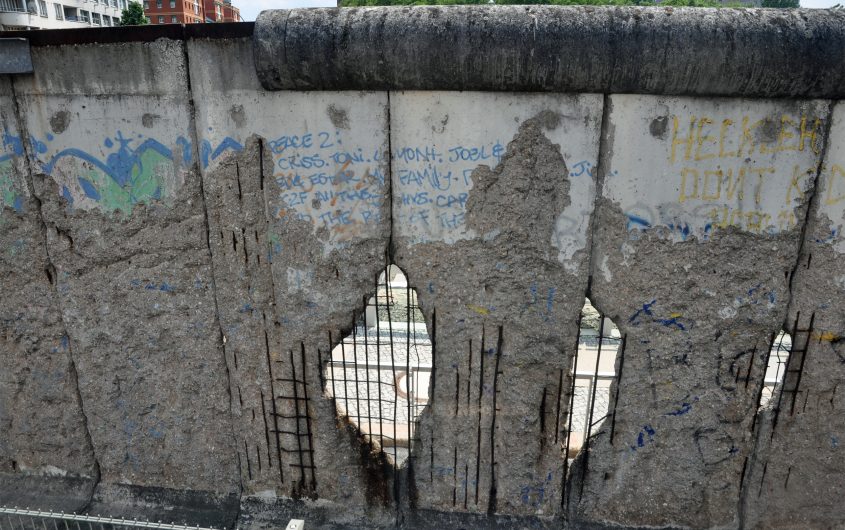
Caribb via Flickr
The Berlin Wall: Limits and Legacies of Divisions

Jackson Janes
President Emeritus of AGI
Jackson Janes is the President Emeritus of the American-German Institute in Washington, DC, where he has been affiliated since 1989.
Dr. Janes has been engaged in German-American affairs in numerous capacities over many years. He has studied and taught in German universities in Freiburg, Giessen and Tübingen. He was the Director of the German-American Institute in Tübingen (1977-1980) and then directed the European office of The German Marshall Fund of the United States in Bonn (1980-1985). Before joining AICGS, he served as Director of Program Development at the University Center for International Studies at the University of Pittsburgh (1986-1988). He was also Chair of the German Speaking Areas in Europe Program at the Foreign Service Institute in Washington, DC, from 1999-2000 and is Honorary President of the International Association for the Study of German Politics .
Dr. Janes is a member of the Council on Foreign Relations, the International Institute for Strategic Studies, the Atlantic Council of the United States, and American Purpose. He serves on the advisory boards of the Berlin office of the American Jewish Committee, and the Beirat der Zeitschrift für Außen- und Sicherheitspolitik (ZfAS). He serves on the Selection Committee for the Bundeskanzler Fellowships for the Alexander von Humboldt Foundation.
Dr. Janes has lectured throughout Europe and the United States and has published extensively on issues dealing with Germany, German-American relations, and transatlantic affairs. In addition to regular commentary given to European and American news radio, he has appeared on CBS, CNN, C-SPAN, PBS, CBC, and is a frequent commentator on German television. Dr. Janes is listed in Who’s Who in America and Who’s Who in Education.
In 2005, Dr. Janes was awarded the Officer’s Cross of the Order of Merit of the Federal Republic of Germany, Germany’s highest civilian award.
Education:
Ph.D., International Relations, Claremont Graduate School, Claremont, California
M.A., Divinity School, University of Chicago
B.A., Sociology, Colgate University
Expertise:
Transatlantic relations, German-American relations, domestic German politics, German-EU relations, transatlantic affairs.
__
Fifty-seven years ago this week, the most tangible symbol of the Cold War started to emerge in the morning hours of August 13. As the East German government stretched barbed wire across Berlin—and later along the entire length of the border between East and West—what emerged was the most blatant demonstration of a government that most feared its own people. The division lasted another twenty-eight years until it and the government that built it were brought down by the very same people it had feared.
Today that border is marked by signs on highways, by dilapidated guard towers, by a red brick line through the heart of Berlin. In some areas, cement segments still stand to remind us of the national scar, while crosses marking where people died attempting to cross over remind of us the human cost.
Germany’s wall is a memory for some and history for others. The years that have passed since the fateful night in November 1989 make the experience of division less tangible, if still definitive. But the narratives of what division meant for Germans in east and west post-1989 have evolved based on what has been achieved—and what has not. In that effort to find meaning, the imprint of the past weaves together with the immediacy of the present.
But the narratives of what division meant for Germans in east and west post-1989 have evolved based on what has been achieved—and what has not.
In 2018, Germans are living in one of the richest countries in the world with a quality of life better than in any earlier era. It can boast of low unemployment, formidable economic strength, and global export champion. The Federal Republic has created the most sustained stable democracy ever known in German history, even adding 17 million more Germans formerly part of the East German state as participants in that democracy.
It has earned respect for its efforts to deal with the legacies and responsibilities of the Third Reich. It has engaged in rebuilding not only Germany after the catastrophe of WWII, but also supported the building of a European Union. And the peaceful revolution that led to German unity was followed by major efforts to reconnect the two states and merge them back into a shared political community—an ongoing effort.
As the Federal Republic of Germany prepares to mark its 70th anniversary in 2019 with these accomplishments in mind, it must also confront the fact that Germans are plagued by anxieties about the future. The emergence of the far-right Alternative for Germany (AfD) is an expression of voters’ discontent. Understanding why so many citizens cast their votes for a party with virtually no programs or policy products to offer beyond fear and backlash is critical. It is the decline in trust in individuals and institutions as exemplified in the staggering loss of membership of mainstream political parties, in church affiliations, or in other civic affiliations. It is the fear of losing ground in a globalized work force, or the uncertainty about the future of society’s composition. It is the sense that there is no voice responding to these challenges with which one can associate. A sense of inequality combined with a threat to identity and a loss of confidence in leaders have mixed together to generate a desire among some to see an enemy or a conspiracy. And the response? A desire to build protective walls—psychologically if not literally—to hold back the forces of change and rewind history.
And it is not just in Germany. The walls that came down in 1989 were at once real and virtual. The triumph over the real walls seemed immediate whereas the triumph over the virtual walls—the walls in the head—was less evident. Only a few years after 1989 the walls in the Balkans were rebuilt with murderous consequences. While some walls that had divided eastern and western Europe crumbled, others emerged: stark divisions over Brexit, economic tensions between northern and southern Europe, disagreements with Brussels over domestic policies and one of the cornerstones of the European Union, the freedom to move.
The triumph over the real walls seemed immediate whereas the triumph over the virtual walls—the walls in the head—was less evident.
Talk of building a wall was also rampant in the U.S. during the presidential race and after Trump’s inauguration. Fifty-seven years after the Berlin Wall was built, and twenty-nine years after it fell, we seem to be witnessing the desire to construct other walls, motivated by fear and anger and constructed just as much by vitriol as by barbed wire.
Walls in the head may be much harder to take down than physical walls. Germany is an illustration that both are possible to overcome. But it is also a reminder that they can reappear despite the lessons of history.








